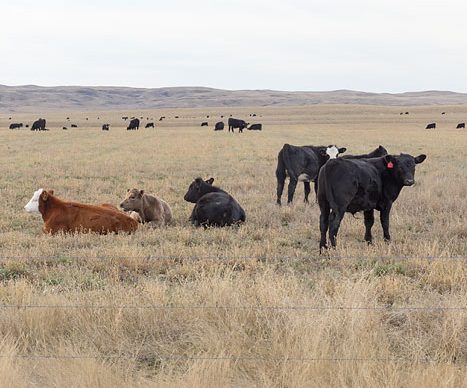Abnormal Weather Doesn’t Grow Average Forage
Remarque : cette page web n’est actuellement disponible qu’en anglais.
This article written by Dr. Reynold Bergen, BCRC Science Director, originally appeared in the October 2017 issue of Canadian Cattlemen magazine and is reprinted on the BCRC Blog with permission of the publisher.

Averages are useful statistics, but sometimes averages can be misleading. As the University of Saskatchewan’s late Iain Christison said, “the average human has one breast and one testicle”. Canada’s rainfall may be close to average this year – but much of the country is experiencing severe drought, and most of the rest is soaked. Either way, low yields, unharvestable or spoiled forage mean that winter feed supplies will be below average in many places, and nutritional value likely won’t be average, either.
For instance, drought-stricken pastures and forage crops have lower levels of carotene, which cattle need to produce vitamin A. A recent paper from Cheryl Waldner and Fabienne Uehlinger of the Western College of Veterinary Medicine (Can. J. Anim. Sci. 97:65-82) looked at 150 beef cow-calf herds in Alberta and Saskatchewan. Calves born the spring following a drought had a much higher risk of vitamin A deficiency, and calves with severe vitamin A deficiency were nearly three times more likely to die than those with higher levels.
Copper deficiency is also a concern for many areas of Canada, even on a good year. Sometimes copper levels are simply too low. Sometimes copper is present in the forage or feed, but is unavailable because it is bound up by sulfates, molybdenum, or both. In drought conditions, sulfate levels in dugout water can rise to the point that it can cause copper deficiency as well as other problems. Weather may also impact molybdenum levels. Cheryl Waldner and Leeanne van de Weyer sampled 66 beef cow herds in Western Canada, and found that cows’ serum molybdenum levels were more than twice as high in areas that had more than 300mm of rainfall during the growing season compared to areas with less rainfall (Can. J. Anim. Sci. 91:423-431).
In addition to vitamins and minerals, energy and protein will probably not be “average” in this year’s forage crop, either. Testing your water and feed is important for you and your nutritionist to appropriately supplement whatever nutritional imbalances you may (or may not) be facing.
But is the supplement eaten? Averages can mislead you here, too. A team of Alberta researchers examined individual intakes of loose mineral supplements and molasses blocks fed in a Growsafe feeder (Can. J. Anim. Sci. 80:681-690). The trace mineral mix was formulated to meet individual cow requirements when consumed at 100g per head per day. Over the six-day trial, mineral intake averaged 183.5g per head per day, and many cows ate enough. But some ate absolutely none, while some ate 900g per day. The molasses blocks targeted an intake of 500 to 1000g per head per day. Over the course of a month, heifers consumed an average of 572g per day. But individual heifer intakes ranged from 2 to 976 g per day.
An animal doesn’t need to exactly meet its nutrient requirements every day. But over time, they do need to have a balanced diet. A total mixed ration (TMR) makes it easier to ensure that each animal consumes the nutrients it needs – that’s why feedlots use them. A Beef Science Cluster study led by Steve Hendrick of the Western College of Veterinary Medicine compared mineral supplements fed free-choice vs. in a total mixed ration. Pregnant Hereford-cross cows (121) and bred heifers (48) were split into four groups of roughly equal numbers of cows and heifers. For the last 75 days of pregnancy, two groups were fed barley silage, with loose free-choice minerals in a separate tub. The other two groups had the mineral mixed in with the silage as a TMR. After calving, one of the free-choice mineral groups was switched to the TMR, and one of the TMR groups was switched to free-choice. Blood samples were collected from all cows and heifers in early January, all dams and their calves within a week of calving, and all animals at the end of the trial (May 24). Calf health, growth and cow rebreeding performance were monitored. Cows fed free-choice minerals were six times more likely to be copper deficient at calving compared to cows fed the TMR, and cows fed free-choice minerals both before and after calving were 47 times more likely to be copper deficient than cows fed the TMR ration throughout. Calves with inadequate copper levels at birth were 6.4 times more likely to be treated for pneumonia, scours or navel infection. Cows fed mineral in the TMR came into heat 2.3 times faster and became pregnant sooner than cows fed free-choice mineral.
Extreme moisture conditions can greatly impact the nutritional content of your forage, the nutritional state of your herd, and the health of your calves next year. A TMR may not be cost-effective for everyone. But your nutritionist can likely help develop an effective way to mix and deliver vitamin, mineral, protein and/or energy supplements in a way that appeals to more than the average cow.
Click here to subscribe to the BCRC Blog and receive email notifications when new content is posted.
The sharing or reprinting of BCRC Blog articles is typically welcome and encouraged, however this article requires permission of the original publisher.
We welcome your questions, comments and suggestions. Contact us directly or generate public discussion by posting your thoughts below.